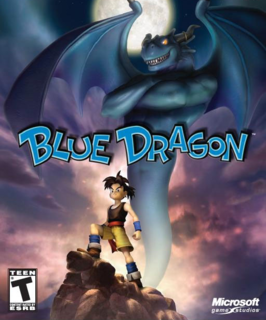Plagued by its own hype, Blue Dragon failed to become what many had expected it to be.
The idea that gave birth to Blue Dragon was rippled from the clear waters of a Hawaii Beach. True to its roots, Blue Dragon feels almost prismatic - an impression helped by the clear presentation and crisp graphics. Incredulously, the modern presentation is complemented by a simple game play that can only be described as antique. In what is known by many as Chrono Trigger Number 2, the magician avoided dipping his wand into the tainted waters of modern RPGs, which quite regrettably, seemed to have been the main criticisms of many.
Following a losing battle with the Landshark that had threatened so many lives in Talta town, Shu and his friends found themselves hearing voices which commanded them to swallow the mysterious orbs. In true desperation, they did just that. Magical forces began to surge within their bodies, and as they turned their heads they saw their new found powers- shadows. What stood in front of them were a Dragon, a Minotaur and a Phoenix, all of which manifested in majestic forms. Accompanied by these new comrades, the tale of Blue Dragon unfolds. While the story isn’t terribly intriguing, it brought the genre back to its days of absolute simplicity. Game play epitomizes as such, with simple turn-based mechanics replacing the complicated engines found in many modern games. Players will find it hard to complain, as the streamlined battles fit the pace of the game like a hand is to a glove; a fact further helped by the pleasant absence of random battles. There is room for novelty, albeit damaged by flaws. First, the shadows in the battles served as a cheerful sight, if not for the occasional frame rate problem. Second, the ability to cast barriers that kills off enemies off fields is a wonderful idea, if not terribly exploitable.
Under the art direction of Akira Toriyama, its graphics may remind players of those in his prior works- Dragon Ball and Dragon Quest. The latter were, however, not armed with the technical prowess of a next-generation console system. Rendered by the powerful Xbox 360, the polished graphics of Blue Dragon exudes a charm brought only possible by this unique blend of fantasy and realism. While most beautiful to look at, the graphics also delivered at a consistent level. Be it the icy mountains, the fiery pits or the prismatic waters, players would be hard pressed to find their save-the-world agenda peppered with abrupt stoppages just so for little breaks to marvel at this artistic excellence.
The subtlety in most of the musical tunes is disrupted by the boss music, a heart-pumping song that reminds one of the early 80’s Rock and Roll. Whether that stood-out song is good is easily debatable; but one can’t help but admire the sheer outrageousness of it. Voice acting, another mainstay in modern games, was decent; although it’s expectable that a particular whiny voice would not ring well in many gamers.
If there is something such as simplicity overkill, then Blue Dragon is quite guilty of committing such a crime. Although the digest-able core game play is most welcome, battles are shamefully easy and forgettable. Similarly, character customization could have helped with a little more depth and options. There are plans for a downloadable content for a greater difficulty on Xbox live, but until then, Blue Dragon is stained. The lack of a really powerful optional boss is also a taboo in the genre; Sakaguchi had broken one rule too many.
While Blue Dragon has easily demonstrated that it is not the RPG powerhouse many have had expected, it is still an enjoyable game at its core. The simplicity of the game could find an easy excuse for itself: to allow the RPG-shy crowd of the Xbox 360 an easy get-into. To veterans, however, the lack of any real difficulty would have only left them wondering what the game could have otherwise be.

